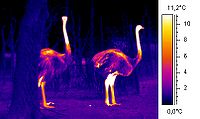
Photo from wikipedia
River regulation can modify natural flow regimes with deleterious effects on aquatic communities. While the effects of flow manipulation on the physical environment and populations and assemblages of aquatic organisms… Click to show full abstract
River regulation can modify natural flow regimes with deleterious effects on aquatic communities. While the effects of flow manipulation on the physical environment and populations and assemblages of aquatic organisms have been described thoroughly, how and to what extent river regulation influences ecosystem processes like food web architecture is less studied. Emergent aquatic insect prey can provide an important food resource to riparian consumers like birds and bats with concomitant consequences for nutrient cycling through aquatic–terrestrial food webs, thus potentially increasing the spatial influence of river regulation into the riparian zone and beyond. We used naturally abundant stable isotopes of carbon and nitrogen to compare food web architecture (trophic position and reliance on an aquatic nutritional pathway) leading to birds and bats between a regulated river, the Tuolumne River downstream of Hetch Hetchy Reservoir, and an adjacent unregulated river, the Merced River, located in Yosemite National Park on the west slope of the Sierra Nevada, California, USA. We found that both birds and bats derived >50% of their nutrition from food webs originating in photosynthesis by algae. In addition, birds and bats occupied a similar trophic position to predatory fish in other systems. Both birds and bats seemed to rely more strongly on an aquatic nutritional pathway during the dryer year of our study period, underscoring the potential importance of emergent aquatic prey as a water subsidy in dry systems and in dry years. In the Tuolumne River, reservoir managers strive to simulate characteristics of the natural flow regime, including seasonal scouring flows and prolonged floodplain inundation. Although we found no conclusive evidence of an effect of river regulation on food web responses, our study suggests that nutrient cycling through aquatic–terrestrial food webs expands the potential influence of river regulation to organisms and ecosystems typically characterized as terrestrial.
Journal Title: Ecosphere
Year Published: 2020
Link to full text (if available)
Share on Social Media: Sign Up to like & get
recommendations!